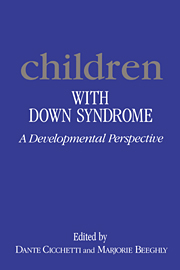Book contents
- Frontmatter
- Contents
- List of contributors
- Preface
- 1 Applying the developmental perspective to individuals with Down syndrome
- 2 An organizational approach to the study of Down syndrome: contributions to an integrative theory of development
- 3 Temperament and Down syndrome
- 4 Interactions between parents and their infants with Down syndrome
- 5 Attention, memory, and perception in infants with Down syndrome: a review and commentary
- 6 Sensorimotor development of infants with Down syndrome
- 7 The growth of self-monitoring among young children with Down syndrome
- 8 Early conceptual development of children with Down syndrome
- 9 Language abilities in children with Down syndrome: evidence for a specific syntactic delay
- 10 Beyond sensorimotor functioning: early communicative and play development of children with Down syndrome
- 11 Peer relations of children with Down syndrome
- 12 Families of children with Down syndrome: ecological contexts and characteristics
- 13 Early intervention from a developmental perspective
- Name index
- Subject index
9 - Language abilities in children with Down syndrome: evidence for a specific syntactic delay
Published online by Cambridge University Press: 02 November 2009
- Frontmatter
- Contents
- List of contributors
- Preface
- 1 Applying the developmental perspective to individuals with Down syndrome
- 2 An organizational approach to the study of Down syndrome: contributions to an integrative theory of development
- 3 Temperament and Down syndrome
- 4 Interactions between parents and their infants with Down syndrome
- 5 Attention, memory, and perception in infants with Down syndrome: a review and commentary
- 6 Sensorimotor development of infants with Down syndrome
- 7 The growth of self-monitoring among young children with Down syndrome
- 8 Early conceptual development of children with Down syndrome
- 9 Language abilities in children with Down syndrome: evidence for a specific syntactic delay
- 10 Beyond sensorimotor functioning: early communicative and play development of children with Down syndrome
- 11 Peer relations of children with Down syndrome
- 12 Families of children with Down syndrome: ecological contexts and characteristics
- 13 Early intervention from a developmental perspective
- Name index
- Subject index
Summary
It has been claimed that the development of language in children with Down syndrome is but a slow-motion replica of the normal course of acquisition, identical in all respects but rate of acquisition (Lenneberg, 1967). Despite delays in the onset and timing of language development, the language structures that are acquired by children with Down syndrome have consistently been described as normal and unremarkable in the order of their appearance. In the speech of children with Down syndrome, there has been no evidence of deviant forms or constructions not observed at some stage of normal development (Bloom & Lahey, 1978; Evans & Hampson, 1968; Rondal, 1975; Rosenberg, 1982; Ryan, 1975).
Our discussion does not challenge the standard view of Down syndrome language as “delayed without deviance.” How it differs is by shifting attention away from the issue of deviance (or lack thereof) to focus upon substantial, unexplained delays in acquiring language structure. In particular, this chapter covers two robust features of Down syndrome language that have previously drawn little attention, but which call for an explanation. The first is that the ultimate syntactic and morphological levels achieved by most individuals with Down syndrome are consistently low across a number of studies, independent of assessment procedures. The second is that this limited language development cannot be explained as a simple function of general intellectual development, or as a function of more general verbal or communicative skill (see Beeghly, Weiss-Perry, & Cicchetti, Chapter 10, this volume). In making these points, the evidence for a specific syntactic deficit is examined, and it is asked whether particular areas within syntax or morphology pose special difficulties for the child with Down syndrome.
- Type
- Chapter
- Information
- Children with Down SyndromeA Developmental Perspective, pp. 302 - 328Publisher: Cambridge University PressPrint publication year: 1990
- 128
- Cited by



